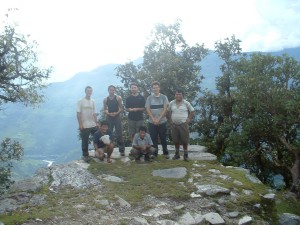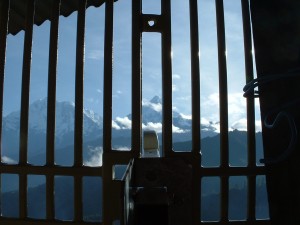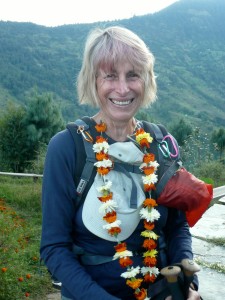Continuing in the same manner as the Pokhara, Nangi and Mohare Dande wireless setup the group walked their way across the Myagdi District. A strange sight they were in those early wireless days when the Internet was just reaching Nepali cities such as the capitol Kathmandu. Can you image the sight as the team and porters carried the equipment up and down the mountains through villages which rarely saw foreigners much less those burdened with huge antenna and space-age looking satellite dishes?

Team on way back to Nangi. James, JoAnn, Sage, Robin, Mahabir (standing). All photographs courtesy of Dr. Robin Shields.
The team moved on to Sikha, a small village with a school on the Annapurna Circuit. They set up an antennae with a radio and cable connected to a computer. This setup was aimed at another high mountaintop ridge called Kopra. Kopra would act as another relay station and was already gaining popularity as a trekking destination. From Kopra‘s ridge you can gaze at Annapurna South and over to Mohare Dande. The same setup was then placed in Pauwdar, a cheese making village close to the Annapurna Circuit. Their school had a few more computers which were connected to the wireless system.

View to Khopra through antenna at Mohare Dande.
The team then made the high trek to Kopra to test the Sikha and Pauwdar connections. Using Kopra as the relay station the equipment at Mohare Dande was able to “see” these villages and provide Internet access from the Pokhara server. One more village was included in the system. Tikot, an especially remote village, which at that time did not have a road or access to any of the trekking routes. I have visited Tikot and found it to be a phenomenal village. I was impressed by the village elders who considered carefully their decisions and how it affected the the whole community. This village had one computer which was added to the system via the Kopra relay.
Finished, the team headed back to Nangi and then Pokhara. They had no trouble from the Maoists who were roaming the area searching for volunteers. Mahabir told me those Maoists were teenagers who didn’t recognized the wireless equipment or have any understanding of it’s potential function. Mahabir had long ago made it clear to the Maoists he had no political agenda…so he posed no treat and was left to come and go without threats. The team faced challenges and one member left the trek due to illness. Another suffered a leg laceration…when getting out of a taxi and falling in a large pot hole in Pokhara. Fortunately I was available to clean and suture the wound at Mahabir’s home in Pokhara. Funny to watch these young men from the team one by one turn green and leave the room during the procedure…after they had braved landslides, Maoists, juga and weeks of arduous trekking in remote areas.
Would you volunteer for a project such as this? Have you been involved in dangerous projects? Share your story with my readers and join me next week as we begin a new chapter in the life of Mahabir Pun.




